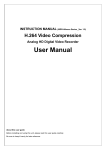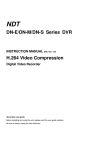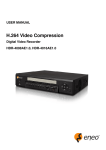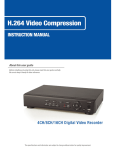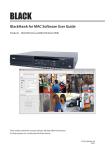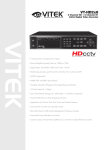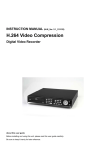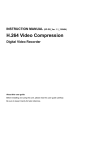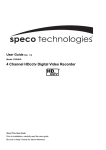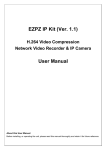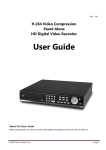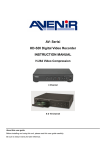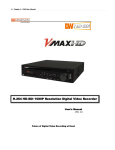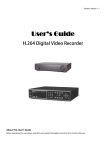Download H.264 Video Compression - Canada(Toronto)CCTV Security
Transcript
INSTRUCTION MANUAL (New ND_Ver. 1.0_20120710) H.264 Video Compression Digital Video Recorder About this user guide Before installing and using this unit, please read this user guide carefully. Be sure to keep it handy for later reference. Safety Precautions Explanation of Graphical Symbols This symbol indicates the presence of important operating and maintenance (servicing) instructions in the literature accompanying the product. This symbol indicates the presence of uninsulated ”dangerous voltage” within the product’s enclosure that may be of sufficient magnitude to constitute a risk of electric shock to persons. WARNING To reduce a risk of fire or electric shock, do not expose this product to rain or moisture. CAUTION Changes or modifications not expressly approved by the manufacturer may void the user’s authority to operate this equipment. CAUTION Danger of explosion if battery is incorrectly replaced. Replace only with the same or equivalent type recommended by the manufacturer. Discard used batteries according to the manufacturer’s instructions. 2 These precautions must be followed for safety reasons. Warning Do not use if the unit emits smoke, strange sounds are heard or odor is emitted. - Continued use may cause electrocution and/or fire. Immediately remove the power plug from the outlet. Once the unit stops emitting smoke, consult the dealership where this unit was purchased or factory shop for repairs. - Do not attempt repairs on your own. Make sure the power cable is not damaged. - Always use the power cable supplied with the unit. - Do not place heavy objects on the power cable or place the power cable near heating equipment. Also, do not bend the power cable forcefully, work upon or staple it. A damaged power cable may result in fire and/or electrocution. - Should the power cable become damaged it must be replaced by the dealership where this unit was purchased or factory shop. Make sure there is no dust accumulation on the power plug or the outlet. - Dust accumulation may result in a short-circuit and heat generation and cause fire. - Be especially careful when using an outlet situated in a room exposed to high humidity, condensation and/or dust, or in a kitchen. - Periodically remove the power plug from the outlet and clean any dust and dirt between the plug and the outlet. Caution when connecting the power cable - Connect the power plug directly with the outlet. Faulty connection may result in heat generation and cause fire. - Do not use the power cable while it is tied in a bundle. This may result in heat generation and cause fire. - When using the extension cord supplied, make sure the power consumption of the connected unit does not exceed the electrical rating of the extension cord. Higher power consumption may result in heat generation and cause fire. Disassembly prohibited - Do not place your hand inside this unit as this may cause fire and/or electrocution. - Consult the dealership where this unit was purchased or factory shop for diagnostics, adjustments, and repairs. Do not place any foreign objects inside the unit. - Do not insert or push in any metal or combustible object through openings such as air ducts. This may cause fire and/or electrocution. 3 - In the event that a foreign object is inside the unit, turn off and unplug the unit. Consult the dealership where this unit was purchased or factory shop. Continued use may result in fire and/or electrocution. Do not place a container holding water or other liquids above the unit when it is connected to power. - In the event that water gets inside the unit, turn off and unplug the unit. Consult the dealership where this unit was purchased or factory shop. Continued use may result in a fire or electrocution. Do not allow the unit to get wet. - This unit is not waterproof. Do not expose the unit to water. This may cause fire and/or electrocution. Do not use in a bath or shower room. - In the event that the internal components have been exposed to water, turn the power off and remove the power plug from the outlet. Consult the dealership where this unit was purchased or factory shop. Continued use may cause electrocution and/or fire. Do not use during thunder/thunder storms. - Do not use during thunder/thunder storms. Never touch the connection cable during thunder/thunder storms. This may cause electrocution. Do not place in an unstable position. - Doing so may cause accidents and/or breakdowns through falling or toppling. - In the event that the unit has been dropped or the casing has been damaged, turn the power off and remove the power plug from the outlet. Consult the dealership where this unit was purchased or factory shop. Continued use may cause electrocution and fire. Do not expose to shock or vibration. - Stored data may be damaged or lost through hard-disk breakdowns caused by shock/vibration. Do not use this unit in areas where it is exposed to the possibility of explosion. - Do not use this unit in areas where explosive and/or flammable gases are present. This may cause fire and/or explosion. For pluggable equipment, the socket-outlet shell be installed near the equipment and shall be easily accessible. Caution Do not pull on the power cable when removing the power plug from the outlet. - Hold the power plug when disconnecting the power cable from the outlet. Pulling on the power cable from the outlet. Pulling on the power cable may damage the cord. This may cause fire and/or electrocution. Do not touch the power plug with wet hands. - Doing so may result in electrocution. Do not sit on. - Doing so may cause the unit to fall, be damaged and/or result in injury. 4 Make sure the cables are connected properly. - Connect and install the power cable and connection cable very carefully. Tripping over the cable may result in the unit capsizing or falling and cause injury. Do not place heavy objects on connected units. - Doing so may affect the stability of the unit and cause it to fall which may result in injury. Doing so may also damage the unit depending on the weight of the object. Shipment and portability - Never move this unit while the power is turned on. - When shipping, remove the power plug from the outlet, confirm that the connection cable has been removed, and store in original packaging. Ship using a method that causes the least amount of shock and/or damage to this unit. Also, do not drop this unit. Maintenance when the unit is going to remain unused for long periods of time - Remove the power plug from the outlet when the unit is going to remain unused for long periods of time. Cleaning the internal components - Consult the dealership where this unit was purchased or factory shop for cleaning internal components. Leaving the unit unused for long periods of time may attract duct to the internal components, which in turn may cause fire and/or breakdowns. Do not block the cooling fans or air ducts. - This unit it equipped with air ducts and cooling fans in order to assist the ventilation of hot air produced by the hard disk drive. Placing covers, placing in a case, or placing inside bookcases may cause heat build up, and may result in fire and/or electrocution. - When the unit is set up in a rack, leave open space on all sides. . Leave 5 cm or more of space above and below. . Leave 10 cm or more of space on both sides and on the rear. Do not expose to extreme temperatures or humidity changes. - ± Do not place in areas where the unit will be exposed to extreme temperatures ( 10 degrees C per hour) or humidity changes. Points on unit positioning - This unit is constructed using precision electronic parts. Avoid placing it in areas described below as this may cause faulty operation and/or breakdowns. . In direct sunlight . In places exposed to water . In the vicinity of cooling and heating units or humidifiers . Near the air conditioner where the unit is exposed to cool air . Dusty areas . Areas that contain fire hazards . In the vicinity of volatile substances . Areas where the unit will be exposed to constant vibration (in trains, cars, etc.) 5 Cautionary points on condensation - Droplets may form on the outside when very cold water is poured into a cup. In the same way, droplets may form around the internal components of his unit. This is called condensation. - Do not use this unit if condensation has formed. Using this unit while condensation is formed may cause breakdowns. In the event of sudden sharp temperature changes, turn off the power and do not use this unit until the temperature of the room where it is positioned stabilizes (about 2 hours). Condensation will not occur while the power is turned on. - When condensation is likely to occur… Use the unit after turning the power off and leaving it for 1~2 hours. Back up battery - This unit has got a built-in lithium battery used to back up the clock function. The battery continues to operate the clock even when there is a power disruption. - The life expectancy of the battery is approximately 2 years. If the battery runs out or leaks, the clock resets when the power is turned off. - Battery fluid leaks . In the event that the battery fluid has leaked rinse hands/clothes thoroughly with water. . Loss of eyesight may result if battery fluid enters the eyes. Do not rub the eyes. Immediately rinse with clean water and consult a physician. - When disposing of this unit . Consult the dealership where this unit was purchased for information concerning the disposal of the lithium battery. Warning Installation and servicing should be performed only by qualified and experienced personnel. Turn off the power of the DVR when connecting cameras, audio or sensor cables. The manufacturer is not responsible for any damage caused by improper use of the product or failure to follow instructions for the product. The manufacturer is not responsible for any problems caused by or resulting from the user physically opening the DVR for examination or attempting to fix the unit. The manufacturer may not be held liable for any issues with the unit if the warranty seal is removed. Warranty for Critical Parts ℃ environment) HDD and Battery: 2 years (25 Cooling Fan: 3 years (25 ℃ environment) 6 Product Components (for ND-M series) The package contains the main unit and its components as specified below. When you purchase the unit, Please check to ensure the components specified below are included. DVR Set Mouse Client Software CD / Remote Control / Quick Guide DVDRW HDD HDD mounting mounting bracket & Screw & / /Battery bracket / & / Screw HDD/DVDRW DVDRW data fixing screw power cable Adaptor(DC 12V 5A) DVDRW & Power Cable (Option) Product Components (for ND-S series) The package contains the main unit and its components as specified below. When you purchase the unit, Please check to ensure the components specified below are included. DVR Set Mouse Client Software CD / Remote Control / Quick Guide DVDRW HDD HDD mounting mounting bracket & Screw & bracket / / HDD/DVDRW DVDRW data cable Adaptor(DC 12V & & Screw fixing screw 6.67A) / /Battery DVDRW Power (Option) Cable Audio Cable 7 power Basic function of the MOUSE ①: Left button: SELECT function ②: Wheel: MOVEMENT function on a drop-down menu Mounting HDD or DVDRW (for ND-M series) 1. Before installing bracket and screws onto HDD 2. After installing bracket and screws onto HDD. 3. Installation HDD and Bracket onto base case (Inside) 4. Installation HDD and Bracket onto base case (Outside) 8 5. After connecting power cable and data 6. Whole picture after installation HDD cable with HDD and DVD-RW Mounting HDD or DVDRW (for ND-S series) 1. Remove the screws and the top cover as specified below. 2. Mount the HDD into the mounting bracket as specified below. 3. Insert the HDD bracket and mounting screw as specified below. 9 4. Connect the HDD SATA and HDD power cable as specified below. NOTE) A system has DATA ports like the above red box. (A number of port could be different from a model.) It would be better when installing the first HDD to HDD1 port because the system recognizes the first HDD as a master HDD. For a system stability, it would be better to keep the position and a number of HDD at the first installation. The system has to be power off to add or remove some HDD in use, unavoidable. Available Model and Maximum Recording Speed Recording Speed (Maximum) Model D1 Resolution (704x480/704x576) 8ch NTSC 240/240fps, PAL 200/200fps 16ch NTSC 480/480fps, PAL 400/400fps Specification ITEM ND-M series Video Compression H.264 Video Input 8/16 Composite (NTSC/PAL Auto Detection) ND-S series 1 HDMI (Max. 1920x1080p60 and Various Resolution) 1 VGA (Max. 1920x1080p60 and Various Resolution) Video Output 1 CVBS (704x480 / 704x576) and 1 SPOT (704x480 / 704x576) - 8/16 LOOP Audio Compression G.711 Audio Input 4CH Audio Output 1 RCA, 1 HDMI Sensor Input 4 TTL, NC/NO Selectable 8/16 TTL, NC/NO Selectable Alarm Output 1 Relay Out by Sensor, Motion and Video Loss 2/4 Relay Out by Sensor, Motion and Video Loss 8/16CH 10 POS 1 RS-232C (DSUB 9) PTZ 1 RS-485 Keyboard Controller 1 RS-485 USB 2 USB 2.0 (1 Front Panel and 1 Rear Panel) Network 1 Gigabit Ethernet (RJ-45), Auto MDI/MDIX Multiple Operation Pentaplex (Live/Recording/Playback/Backup/Network) Live Zoom Digital Zoom (Zoom-in for the selected area) Motion Detection Yes Recording Resolution NTSC(704x480, 704x240, 352x240) or PAL(704x576, 704x288, 352x288) per Channel Recording Quality 5 Levels Recording Mode Continuous, Schedule, Motion, Sensor, Manual 11 PTZ button. A PTZ control window displays when clicking this button. Sequence button. Click this button to use a sequence function. Manual Record button. Click this button to record at once. Alarm-out function On/Off button. An alarm is stopped and an alarm setup lamp is right out when it clicks this button during the alarm is in progress. Click the split screen icon to change the current split screen mode using the mouse or SEL button. Displays the current date and time. Remote control ID display. If a remote ID is not set, the message “A(all)” is displayed. Displays the amount of recording on the hard disk from 0-99%. Indicates that HDD is recycled. Continuous recording in progress. Manual recording in progress. To set the Manual recording mode, press the Record button on the front panel. Motion alarm recording in progress. Sensor recording in progress. Indicates that the lock is set. To Audio mute. To set audio mute, press the Audio button on the front panel. Single audio display. To set audio single for highlighted channel only, press the Audio button on the front panel. Indicates that alarm is set. To set the alarm function, press the Alarm button on the front panel. Indicates that alarm output is activated. Event indicator. When there is an event (motion recording, video loss, HDD fail, S.M.A.R.T), this icon will be highlighted bright. Indicates that a network client is connected to the DVR. 54 Indicates that sequencing mode is enabled. Table 4.1.2. Button functions in Live Viewing Screen Button Description Arrow Keys Select channel to be displayed in full screen mode. SEL Switch between full screen and quad display mode. SEQ Press to start auto sequencing of the screen in full screen mode. (Toggle) RECORD SEARCH ARCH SETUP ESC Press to start and stop manual recording. Press to go to the search menu. Event search /Time line search /Log /Archive search Press to capture a still image. The still image will be stored into hard drive. It can be transferred to the USB device. Press to launch SETUP menu. Press for temporal storage of the changed value or to return to the previous menu screen. 4-2. SEARCH Screen To enter the search screen, select SEARCH menu on the screen using the mouse or press SEARCH icon on live screen. Figure 4.2.1. Search Screen 55 There are 7 ways of search menu such as TIMELINE, EVENT, GO TO FIRST TIME, GO TO LAST TIME, GO TO SPECIFIC TIME, ARCHIVE and LOG on the screen. 4-2-1. TIME-LINE Search The TIME-LINE search window is used to find the stored video by using the time line bar. When it clicks a Timeline menu, user can see a calendar which has recording data. Select a specific date and time. Use a drag-and-drop function of the mouse control. User can select a specific minutes using a button in the above red box. Press a PLAY button after setting a specific time. Press the PREV to return to the SEARCH window. 4-2-2. Event Search The Event Search window is used to find stored video. 56 Figure 4.2.2. Event Search screen When it clicks an Event menu, user can see a calendar which has recording data. Select a specific date and then user can see all data. Press a PLAY button to playback the data or a SAVE button to save the data at once after selecting a specific data. User can find a data of the specific channel and event using a button in the above red box. Press the PREV to return to the SEARCH window. 4-2-3. Go To First Time You can access from the oldest recorded data on the DVR hard drive by selecting GO TO FIRST TIME on the SEARCH window. Press the PREV to return to the SEARCH window. 4-2-4. Go To Last Time You can access from the last minute recorded data on the DVR hard drive by selecting GO TO LAST TME on the SEARCH window. Press the PREV to return to the SEARCH window. 57 4-2-5. Go To Specific Time Figure 4.2.3. Go To Specific Time User can search for video data from a specific instance by setting the date and time in the Go To Specific Time menu. Use the mouse or the control button (◀ ▲ ▶ ▼) on the remote control to change the date and time value and press the PLAY button after setting. If there are no the video data in the set date and time, the DVR will play the latest video data. 4-2-6. Archive Search The ARCHIVE Search window is used to find previously stored video or images. 58 Figure 4.2.4. Archive Search Screen When it clicks an Archive menu, user can see a calendar which has recording data. Select a specific date and then user can see all data. When it presses a Display button, the still image or the first frame of the selected video is opened and user can save the data. 4-2-7. Log Search You can access the LOG list search screen by selecting LOG on the SEARCH window. Figure 4.2.5. Log Search Screen When it clicks a Log menu, user can see a calendar which has recording data. Select a specific date and press NEXT button. Then user can see all log data. Press SAVE button to save the data and then the data 59 is saved to text file format. 4-3. Play mode During playback of a recorded event, the mode changes from SEARCH to PLAY. While in PLAY mode, you may return to the SEARCH screen by pressing the X button on the status bar or the ESC button of a remote control. Figure 4.3.1. PLAY Mode Screen The following status bar hides automatically and appears again when putting a mouse pointer to the bar. Table 4.3.1. Button functions in PLAY Mode Button Description Return to the previous menu screen, search window, or exit from the Menu ◀◀ Press to rewind the footage at 1x, 2x and 4x speeds. Reverse playback speed is shown as -1x(normal), -2x (2 times normal) and -4x (4 times normal) at the bottom right of the screen. --◀ --◀ ▶/ II ▶-▶▶ Jump/Step backward. The playback position moves 60 seconds backward. Press to play or pause recorded video. Jump/Step forward. Playback position moves 60 seconds forward. Press to fast forward the footage at 1x, 2x and 4x speeds. Playback speed is indicated as +1x, +2x and +4x for normal, twice and 4 times of the regular speed at the bottom right of the screen. Press to backup the video. 60 5. PTZ Control To control the PTZ functions of the camera, select PTZ menu on the screen using the mouse. Select the item you wish to control the PTZ camera and control them using the mouse or the control button (◀ ▲ ▶ ▼) on the remote control. Please refer to the table 5.1. for the control. Figure 5.1. PTZ Control Screen Table 5.1. Button Functions in PTZ Control Item Description INITIALIZE Initialize the PTZ settings of the selected camera. PAN / TILT Select PAN/TILT using the mouse or the control button (◀ ▲ ▶ ▼) and press SEL button on the remote control. Adjust the tilt(UP/DOWN) / pan(LEFT/RIGHT) position using the mouse or the control button (◀ ▲ ▶ ▼) on the remote control. ZOOM / Select ZOOM/FOCUS using the mouse or the control FOCUS button (◀ ▲ ▶ ▼) and press SEL button on the remote control. Adjust the zoom(Mouse Wheel Down or Up/Down button of the remote control)/focus(Mouse Wheel Up or Left/Right button of the remote control)position. OSD Select the OSD to enter the menu. Control keys are Right, Left, UP, Down, Select, Far (REW KEY), and Near (FF KEY). Press the ESC button to return to the main menu. Press the PTZ button to escape from the OSD menu. AUTOSCAN Press the right key (▶) on the control button to start auto scan Press the left key (◀) on the control button to stop auto scan. PRESET Select the PRESET and press the left key (◀) on the control button. Then, number input window will appear. Set the number (3 digits) using the number key and press the SEL to set the preset number for the current position. Press the right key (▶) on the control button and set the number (3 digits) to go to the preset number. TOUR Select the TOUR and press the right key (▶) on the control button. Then, number input window will appear. Set the number (1 digit) using the number key and press 61 SEL to make the group number work. Press the left key (◀) on the control button to stop tour. User can set the preset number in the tour group of the OSD menu. NUMBER Avail ble only on the TOUR and PRESET menu. Press the ESC button to return to the main menu. Preset/ Tour/ OSD/ Autoscan function are available on the specific model AP8777 and PMA-200. (Select it in the NAME of PTZ setup menu) 6. Back up 6-1. Still Image backup onto USB flash memory Still images can be captured and archived onto the USB stick or hard drive in live mode or while playing back recorded video. In live mode, press the BACKUP button to launch the archive function or select BACK UP menu on the screen using the mouse. 1. Select a specific channel which wants to backup on live screen. 2. When you press BACKUP button, the archiving screen will display as Figure 6.1.1. 3. Once you press Backup button, the system will start to archive the data to the selected media. Figure 6.1.1. Still Image Archiving and Backup Screen NOTICE For a backup using a USB stick, a format of the USB stick has to be set to FAT32. 6-2. Video backup onto USB flash memory Video can be captured and archived onto the USB stick or hard drive while playing back recorded video. In playback mode, press the BACKUP button to launch the archiving function. 1. When you press BACKUP button, the DVR will ask whether to archive a Still Image or Video clip. 2. If the user selects VIDEO, the DVR will ask for the media. To use the huge backup, the external USB HDD has to be mounted. 3. After selecting the media, the DVR will ask for the channel and the setting of the archiving duration. If the huge Backup is selected, the duration is from 1 hour to 24 hours. 4. After selecting the channel and setting of the duration, the system will start to archive the data to the selected media. 62 Figure 6.2.1. Video Archiving and Backup Screen The DVR will convert the corresponding portion of the video into an AVI file. 6-3. Transferring still images or video from the ARCHIVE list The stored data onto hard drive will be found in the ARCHIVE list in SEARCH window. User can back up still images or video into the storage device from the ARCHIVE list. 1. Select the date to begin searching and navigate through the days using the mouse or the control button (◀ ▲ ▶ ▼) on the remote control. 2. Once you have selected the date, press NEXT button to open the list of stored data. 3. Use the mouse or the control button (◀ ▲ ▶ ▼) on the remote control to scroll through the on-screen listings. 4. Select a list of stored events that happened previous to or after the current selection. 5. Once the desired event has been selected, press NEXT button to view the still image or the first frame of the selected video. 6. Press the BACKUP button to launch the archiving function in playback mode. 7. Press CLOSE button to return to the SEARCH window. 63 Figure 6.3.1. Archive Search Screen 6-4. Playback of Backup Video NSF format: NSF format video can be played back by the player (the HD player) that the DVR copies on USB thumb drive with video. Two folders are copied on USB thumb drive - BACKUP DATA: NSF format video file and INDEX file for a title file of date and time - HD PLAYER: Exclusive video viewer. 64 AVI format: It can be played back by Window Media Player™ or other media player that is compatible with AVI format video. 7. Upgrading Firmware In order to upgrade, the firmware upgrade file must first be downloaded and copied into the USB memory stick. Create a new folder in the USB memory stick and name it “upgrade”. Copy the firmware upgrade file “xxxxxx.bin” into the “upgrade” folder. NOTICE A format of the USB stick has to be set to FAT32. The folder on the USB memory stick must be named “upgrade”. After the firmware upgrade file is copied into the USB memory stick, connect the USB memory stick to the USB port on the front or rear panel and do the followings: 1. Go to Config menu of Setup. 65 2. You can see the following message when pressing the software upgrade menu after putting the USB memory stick on the system. 3. You can see the following message when pressing the scan button. Please check the current firmware version and the firmware version which you want to upgrade. The system will upgrade automatically when pressing the upgrade button. After upgrading, the system should be restarted. At that time, the USB memory stick has to be pulled out on the system. 4. You could see the following warning message if you don’t pull out the USB memory stick. 66 Remote Firmware Upgrade User can upgrade the firmware via Network as follows. 1. Go to the Remote Setup menu on the UMS Multi or Web Viewer. 2. Press the password for admin. Just admin is possible to connect to the remote setup menu. 67 3. Go to the Remote Upgrade menu. Then, you can see the current F/W version as follows. To upgrade a new F/W, insert the F/W in your PC and press the UPGRADE button. 68 4. Then, you can see the following progress bar and it would be taken around 150 seconds to upgrade. 69 5. When finishing the upgrade, the network streaming would be connected again automatically and you can see the following screen. Please check the current F/W version if the upgrade is succeeded. 8. Network access using the Exclusive network viewer, UMS single The DVR provides a live remote monitoring feature. Remote monitoring requires installation of the network viewer on your PC. NOTICE In a high bandwidth network, a maximum of four users can access one DVR simultaneously. In a low bandwidth network it is recommended that only one user access the DVR at a time. 8-1. PC requirements Ⅳ 1.4Ghz or higher CPU: Intel Pentium Memory: 512MB (1GB or higher is recommended.) VGA memory: 16MB (64MB or higher is recommended.) Resolution: 1024x768 O/S: Windows 2000, XP Professional, XP home Direct X: DirectX 8.1 or higher 8-2. Installing the network viewer 1. Insert the provided CD in the CD drive and double-click “UMSClient(XXXX).exe” 2. Select a destination folder and click “Next”. 3. Select the type and click “Next”. 70 4. Select the program folder and click 5. The setup status screen is displayed. “Next”. After the installation is completed, “UMS Client” icon is displayed on the desktop. 8-3. Live monitoring mode and functions. Button Function Description DATE & TIME Displays the current date and time. 71 CONNECT/DISCONNECT Connect/disconnect network connection. SEARCH Switches the live mode to search mode. DISPLAY MODE Select a channel and screen display mode. PAN/TILT/ZOOM/ FOCUS Control the PAN/TILT/ZOOM/FOCUS features on the remote camera. CAPTURE Capture a still image from live screen. PLAY/PAUSE Play/pause live video. ALARM The ON/OFF button of the alarm output of the DVR. When an alarm of the DVR is output, this button becomes Red. Display the setup screen of the network SETUP viewer. HDD USAGE DVR HDD storage Indicator. NETWORK BANDWIDTH Shows the transferred frames and network bandwidth. Adjust the volume. The audio can be AUDIO turned on or off by clicking the audio icon. LOG WINDOW Operations of the display mode of the main screen Single channel display - Click the one of channel button or double-click the channel screen. 72 QUAD/-screen display - Click the QUAD button to switch to quad-screen display Full screen display - Click the maximize button to display only screen and hidden the operation panel. Image capture of live screen Still-image of live screen can be captured and saved as BMP or JPEG file. 1. Click the channel to be captured. Then the channel screen is surrounded with a red line. 2. Click the CAPTURE button. Then the IMAGE CAPTURE dialog is displayed. 3. Set the conditions and click OK button. Then still-image is saved. 8-4. Bi directional audio The UMS Client allows for bi directional audio between the client and a dvr unit. On the PC, to use bi directional audio, you will need a sound card of handling a microphone and speakers. On the dvr side, you will need to connect a microphone to the audio in connection, and a pair of amplified speakers to the audio out connection. 73 8-5. Remote search mode and functions Button Function Description DATE & TIME Displays the recording time of the data selected on the time bar at the bottom of the main user interface. DISCONNECT Disconnect network connection.. LIVE Switches the search mode to live mode. CAPTURE Capture a still image from live screen. MARK IN Set the start time for video backup. MARK OUT Set the ending time for video backup. BACKUP Backup the selected recorded video as AVI format. SEARCH The calendar shows dates with recorded CALENDAR video in a light blue and the selected date in dark blue. The timeline shows recorded data in dark TIMELINE BAR blue on the bar. 74 The playback buttons. PLAYBACK BUTTON DISPLAY MODE Select a channel and screen display mode. Searching and playing video in the remote DVR Video recorded in the remote DVR or Video recorded on the PC can be searched and played back. 1. Connect the network to the remote DVR and press SEARCH button. Then the mode is changed from the live mode to the search mode. Searching the video recorded in the remote DVR: Connect the network to the DVR.. Searching the video recorded in the PC: Do not connect the network to the DVR. 2. Select the date to search the video. 3. Drag the slid on the time scale and drop it between 0 to 24. 4. Press the PLAY button. Then the video recorded in the remote DVR is played back. 75 Backup of video in the remote DVR Video recorded in the remote DVR cab be backed up on the PC HDD as AVI format. 1. Connect the network to the remote DVR and play the video recorded in the remote DVR. 2. Drag the slid on the time scale and drop to the start time for video backup and press the MARK IN button. 3. Drag the slid on the time scale and drop to the end time for video backup and press the MARK OUT button. Then the marked time is displayed in dark green. 4. AVI Backup dialog is displayed. Click the OK button. Then the marked video is backed up. Start time / Stop time: Backup time can be changed. File path: Shows the folder that the backup file is recorded. Channel: Shows backup channel. 8-6. PC System configuration Click the SETUP button. Then the Setup dialog is displayed. 76 Setting General Set the Security Option, Save Path, and Miscellaneous. Security Option: Set a password for security options. When you access any of the selected functions, you will need to enter the password. Save Path: Specify the location to record for backup and still image capture. Automatic reconnection: If a user selects this function, the client S/W will automatically try to connect to the previously connected IP address if the network connection is lost. Display network statistics: If a user selects this function, the client S/W will display network status, Bit rate and Frame rate. Time Format: Change the mode the Client software displays the time. Setting Site The remote DVRs can be added, modified, and removed. Setting Event Set the record path and the size of local disk space for the log files. 77 LOG – Select to save event log into ‘log file’. ICON – Select to display the event on live video. EVENT LIST – Select to show the event in the ‘Event List” window of live mode. Search and check the recorded log data. Setting Record Set the recording conditions and select channels to record. 78 Select the local disk to use and the amount of disk space you want to allow the program to use for recording. 9. Network access using the Exclusive network viewer, UMS multi 9-1. Overview The UMS Multi-Client is a multiple site monitoring client software with; video, audio, and alarm signals from the DVRs over networks. The UMS Multi-Client does not limit the number of DVR units to register. The program displays to up 256 live videos on one display and even playback videos window on the same or another display monitor. On the program, user may control PTZF cameras on the DVRs. By attaching a microphone and speaker system to devices on site, user may make bi-directional audio communication over the network. 9-2. Minimum PC requirements CPU Intel Pentium Ⅳ 2Ghz Memory 512MB or Higher is recommended. VGA 128MB or Higher is recommended. Resolution 1024x768 Disk space 1GB OS Windows 2000, XP Professional, XP Home, Vista (Some versions of Vista has problem in installation. Please contact your vendor for more information.) Network 10/100Base T Others Direct X 8.1 or Higher Before installing the program, check the PC specifications. The DVR remote software may not perform correctly if the PC does not meet the minimum requirements. 79 9-3. Installing the program 1. Insert the provided CD in the CD drive and double-click “UMSMultiClient (XXXX).exe” 2. Select a destination folder and click “Next”. 3. Select the program folder and click “Next”. 4. The setup status screen is displayed. 80 5. After the installation is completed, “UMS Multi Client” icon displays on the desktop screen. 9-4. Live Window When installation is completed, double click the “UMS Multi Client” icon on your desktop to start the program. 9-4-1. Main user interface 9-4-2. Control buttons Button Description Click this icon to run a playback window to search and play LOCAL PLAYBACK videos that are recorded in local PC. Click this icon to run a playback window to search and play REMOTE PLAYBACK videos that are recorded in remote DVR. THUMBNAIL REFRESH: Click this icon to refresh and renew thumbnail image of every connected site. SITE ADDITION: Click this icon to open ‘Site Addition’ window. SITE DELETE: Click this icon to delete site from the index window, after disconnect a site. SITE MANAGEMENT NET FINDER: Select the site from the index window and click this icon to modify the information of specific site. 81 CONNECT DISCONNECT Click this icon to connect the selected site/sites. Click this icon to disconnect the selected site/sites. Click this icon to setup configuration of UMS MULTI CLIENT. SETUP Click this icon to capture a still image CAPTURE EVENT LIST Click this icon to play/pause live video. PAUSE ALARM ON Enable or disable recording of live video to local disk which has RECORD ON set in setup menu. AUDIO Use the volume control bar to set the audio level. Use the micro phone volume control bar to set the micro phone MIC level. User can control PAN/TILT & ZOON/FOCUS. PAN left /right ZOOM in/out TILT up/down FOCUS in/out To select the numbers of display channel/channels (Single, CHANNEL SPLIT quad, 9 channels, and 16 channels) of highlighted site. To select the numbers of DVR/DVRs (1 DVR, 4 DVRs, 9 DVRs, DVR SITE SPLIT 16 DVRs) on main display screen. 9-5. Search and Playback Window 9-5-1. Main user interface You can access to search window by clicking the search icon (Local Playback / Remote Playback) on the upper left of Live Window. 82 9-5-2. Main control panel Button Description Click this icon to run a playback window to search and play LOCAL PLAYBACK videos that are recorded in local PC. Click this icon to run a playback window to search and play REMOTE PLAYBACK videos that are recorded in remote DVR. Directory window shows site/sites that are pre-registered. CONNECT DISCONNECT Click this icon to connect the selected site/sites. Click this icon to disconnect the selected site/sites. 83 Click this icon to setup configuration of UMS MULTI CLIENT. SETUP Click this icon to capture a still image. CAPTURE EVENT LIST Click this icon to set the beginning time for backup of the MARK IN recorded video in AVI format. Click this icon to set the ending time for backup of the recorded MARK OUT video in AVI format. Click this icon to backup the recorded video in AVI format. BACKUP AUDIO Use the volume control bar to set the audio level. To select the numbers of DVR/DVRs (1 DVR, 4 DVRs, 9 DVRs, DVR SITE SPLIT 16 DVRs) on main display screen. To select the numbers of display channel/channels (Single, CHANNEL SPLIT quad, 9 channels, and 16 channels) of highlighted site. To select the channel to playback. The calendar shows dates with recorded video in color. To display the recorded data of selected channel or all channels on a time line scale. 84 To change a time line scale from 24 hours to 60 minutes or vise versa. The timeline shows recorded data in color on the bar. You can adjust the time line scale and move it to the time you wish to playback. Then click the play icon to display the recorded video. Playback buttons. 9-6. Setup of UMS Multi Client Click the setup icon to setup the configuration of UMS Multi Client software. The Setup window displays. 9-6-1. General 9-6-1-1. Security Option: Set a password for security options. Select security options and set a password. Then when you access any of selected functions, you need to enter the password. You can also set the save path for capturing and backup. 85 9-6-1-2. Save Path: Specify the location to save captured still image for Capture and Backup data. 9-6-1-3. Miscellaneous Automatic reconnection: If a user selects this function, client S/W will automatically try to connect the finally connected IP address, after the network is disconnected. Always On Top: If a user selects this function, client S/W will display continuously at the very front than other software on the PC. Time Format: Change the way the Client software displays the time. 9-6-2. Event Event log can be archived and searched. 9-6-2-1. Archiving Event Log: Specify the location to save event logs and select event to archive. 86 9-6-2-2. Archiving Event Log: Event log can be searched from selected time. 9-6-3. Record 9-6-3-1. Record setup: You can set the recording conditions for Always, Event, or Auto record. And you can also select target DVR/DVRs and channel/channels. When you set the recording condition to event, you can set event for motion or alarm with duration. 87 9-6-3-2. Record local storage setup: You can select the local disk to use and the amount of disk space you want to allow the program to use for recording. You can also select the option to overwrite data or stop recording when the maximum amount of disk space is full. 9-6-4. OSD You can select the OSD to be display 9-6-5. Language You can select a language to be display. 88 9-6-6. About “About” provides network client version information. 9-7. Remote Setup The menu settings for the DVR unit can be set from a PC, via network. Put the cursor of the mouse on the channel which is connected to the site and press the right. Then the following window is displayed. Select the Remote Setup. 89 Then the setup window is displayed as follows to check the password for admin. Just admin is possible to connect to the remote setup menu. The specified menu screen is displayed on the upper side of the screen. Setting is basically the same as with the DVR menu setting. 9-7-1. Display 90 User can set the value on this remote setup page. After setting the value, please press the APPLY button. Then the value would be applied to the system without the system rebooting. RELOAD button is used when user want to bring the value in the system. 9-7-2. RECORD 91 9-7-3. DEVICE 9-7-4. STORAGE 92 9-7-5. SYSTEM 9-7-6. NETWORK 93 9-7-7. UPGRADE Please refer to page 54 for the Remote Upgrade. 9-8. Operation 9-8-1. Addition, Delete, and modify of DVR sites 9-8-1-1. Addition of sites 1. Click SITE ADDITION button. And then the following window displays. o Model: User has to select surely a suitable type. SDVR series, H series DVR N series DVR, HD DVR IP Camera 94 o Site Name: Input a name that properly describes a site. o IP Address: Input IP address (Public IP address of a router that DVR is connected.) or Domain name that is registered at www.okddns.com (for Korea), www.ddnscenter.com (for USA) or www.bestddns.com (for other area including EU) o Port No.: Input port number of DVR. o ID: Input ID of DVR. o Password: Input network password of DVR. 2. Click OK button. And then the registered site is added on the directory window. 9-8-1-2. Delete of sites 1. Select the site/sites to delete from the directory window. 2. Click SITE DELETE button. And then the selected site/sites is/are deleted. 9-8-1-3. Modify of sites 1. Select the site/sites to modify from the directory window. 95 2. Click NET FINDER button. And then the following window displays. 3. Click MODIFY button. And then the modified information is applied. 9-8-2. Connect and Disconnect 9-8-2-1. Connect 1. Select site/sites to connect from the directory window. 96 2. Click CONNECT button, and then site/sites displays/display as connected. 9-8-2-2. Disconnect 1. Select site/sites to disconnect from the directory window. 2. Click DISCONNECT button, and then selected site/sites disconnected. 97 9-8-3. Still-image capture during Live 1. Double-click a channel to capture from the display screen. (Otherwise all channels will be captured.). 2. Click CAPTURE button. And then a Capture window displays. 3. Set Save path, File Name, and File Format. And then click OK button. 4. Still image is saved as set in Capture window. 98 9-8-4. Recording video on local PC during Live 1. Click SETUP button. And then a setup window display. 2. Select Record and set the values. 3. Select Disk and set the values. 99 4. Click RECORD ON button. And the color of button is changed. 5. Live video data is recorded as set in Record and Disk setup. These video data can be searched and play-backed with Local Playback. 9-8-5. Local Playback and Remote Playback 9-8-5-1. Playback of recorded video on local PC 1. Click LOCAL PLAYBACK button. And then Playback Window display over Live Window. 2. Select site/sites to connect from the directory window. 3. Click CONNECT button. And then Green bar displays on Search calendar and slide window. 4. Move scroll bar on where there is video data and Play button. 5. Video data that is recorded on local PC will be play-backed. 100 9-8-5-2. Playback of recorded video on remote DVR 1. Click REMOTE PLAYBACK button. And then Playback Window display over Live Window. 2. Select site to connect from the directory window. 3. Click CONNECT button. And then Green bar displays on Search calendar and slide window. 4. Move scroll bar on where there is video data and Play button. 5. Video data that is recorded on a remote DVR is play-backed. 101 9-8-6. AVI Backup during playback You can back up the recorded videos in AVI format during playback. 1. Double-click the target channel to backup. 2. Select the beginning time by using the search calendar and slide bar. 3. Click MARK IN button, when the scale of the timeline is located on the target time as the beginning time of backup. 4. Set the ending time on the blue timeline by dragging the scale on the target time as the ending time of backup and clicking MARK OUT button. Then, color of the timeline between the beginning time and ending time will be changed into dark Green. 5. Click BACKUP. And then the window appears as below. 102 6. You can also set the beginning time and ending time on this window. After selecting a channel for backup, click the OK button. The backup will begin. 7. AVI video data is recorded as set in AVI Backup window. AVI format video can be played back by Window Media Player™ or other media player that is compatible with AVI format video. Notice When it does a backup with NSF format, user can do a playback using the DVR player. The DVR player is installed with the S/W in user’s PC. 103 10. Network – By an web-browser viewer The DVR provides a live remote monitoring feature by web-browser viewer. 1. Check the IP address of the DVR from SETUP>SYSTEM>DESCRIPTION>IP ADDRESS. 2. Input the IP address or Domain name address that you pre-registered on www.bestddns.com on the address field and press “Go”. Please pre-register on www.okddns.com in Korea and on www.ddnscenter.com in USA. 3. Click this bar. Then the dialog box is displayed. 4. Click “Install” to download ActiveX control. 5. Web Browser Viewer is displayed as bellow. 104 6. Click CONNECT button on the Left upper corner of web-viewer. Then “Connect” dialog is displayed. Enter IP address (or Domain name address that you pre-registered on www.bestddns.com, www.okddns.com or www.ddnscenter.com, Port number and Password and click “Connect” Server address: Input IP address of the DVR from SETUP>SYSTEM>DESCRIPTION>IP ADDRESS or Domain name address that you pre-registered on www.bestddns.com, 105 www.okddns.com or www.ddnscenter.com, Port: Input Port number (The number is set on SETUP>NETWORK>PORT.) ID: Input ID of DVR. Password: Input network password of DVR. (The number is set on SETUP>SYSTEM>NETWORK PASSWORD.) 7. Then the cameras connected to the DVR are displayed on the screen. 9. SETUP: The menu settings for the DVR unit can be set from a PC, via network. Refer to the detail of Remote Setup description of UMS Multi Client. Please check the detail to the page 77, Remote Setup. APPENDIX: How to connect network A. How to set IP address of the DVR and open TCP port of the router? The port forwarding is dependent on the brand and model of the router. The port forwarding is required to allow access to the DVR beyond a router. 106 Connect network cable between DVR and Router or ADSL modem. 1. Default network setting on DVR are - Port: 5445 - WEB Port : 80 - Network : DHCP 2. From PC connected in the same Router, find IP address, Gateway, and Subnet mask by IPCONFIG command in command prompt. 3. But if IP is something else like 192.168.x.xxx., you should change IP address, Subnet, Gateway on the DVR. Go to SETUP>NETWORK>LAN of the DVR and change the IP settings to be like IP: 192.168.XXX.XXX and Gateway: 192.168.XXX.XXX. (Refer to the user’s manual of Router.) Open your web browser. Enter the router IP address in the address bar (The router IP address are different with the brand and model.), click GO. 107 4. Enter the user name and password (admin is default) and press the OK button. 5. Select the Port Range Forwarding tab. 6. Enter the each field. i. Application: Enter a description of the DVR (Example: store1) ii. Start: Enter the first number of the port you need to port forward (Example: 5445) iii. End: Enter the last number of the port you need to port forward (Example: 5445) iv. Protocol: Select Both. v. IP address: Enter the IP address of the DVR on SETUP>NETWORK>LAN>IP ADDRESS. vi. Enable: Check the enable box. 7. Select the Save settings button located on the bottom of the window. Then Port forwarding is finished. Network access beyond a router In order to access the DVR remotely beyond a router (firewall), the user must open TCP port for command level, live channels and storage channels. User need to open 2ports numbers on the router; the DVR port number 5445 and the WEB port number 80. If this port is not opened properly, user can not access DVR beyond a router. You can learn how to port forward many kinds of Routers from the bellow site. http://www.portforward.com/english/routers/port_forwarding/routerindex.htm 108 B. How to access DVR from Remote PC? LAN Connection – Using a switching hub Connect to the system, using a hub (Switching hub) and an Ethernet cable (10BASE-T/100BASE-TX CAT 5 LAN cable) 1. Run the pre-install the network client software on the supplied CD. (Refer to Chapter 6. Network access using the Exclusive network viewer) 2. Check the IP address from SETUP>SYSTEM>DESCRIPTION of DVR. 3. Run network client software and click button. 4. Input Site Name, Site Address(IP address), Port No., and Password on the connect window. And click OK. Then, press button after checking the left check box. Internet (ADSL) Connection using DDNS Connect to the system, using an Router or ADSL modem and an Ethernet cable (10BASE-T/100BASE-TX CAT 5 LAN cable) 109 1. Go to SETUP>NETWORK. Set NETWORK TYPE as DHCP and DDNS SERVER as ON. And select one type among bestddns.com, okddns.com and ddnscenter.com after setting to DDNS1. 2. Go to Setup menu of Router and open TCP port 5445 and 80 using Port Forwarding. (Refer to A. How to set IP address of the DVR and open TCP port of the router?) 3. Confirm the Mac address and Serial No. from the label of the rear panel of the DVR. 4. Open the web browser and log on http://www.bestddns.com. Please log on http://www.okddns.com in Korea and http://www.ddnscenter.com in USA. MAC Address: Input the Mac address (EX. 0002690XXXXX) without any space. Serial Number: Input the Serial No. (EX. HD0410SA1100XXX.) without any space. 5. Domain Name: Input Domain Name for your DVR system 6. Click the DUPLICATION CHECK button to see if the domain name is available. 7. If you see the screen “You can use the Domain name you entered” then click RETURN and click REGISTER button to complete the registration. 8. Run the pre-install the network client software on the supplied CD. (Refer to Chapter 8. Network access using the Exclusive network viewer) 9. Click button and add the DVR as necessary. 110 Model: Select one type surely among SDVR series, H DVR series DVR / N series DVR, HD DVR / IP Camera. Site Name: Input the name of the DVR. Site Address: Input the Domain Name that is registered on http://www.bestddns.com. Please log on http://www.okddns.com in Korea and http://www.ddnscenter.com in USA. (EX. XXXXX.bestddns.com) Port Number: Input the DVR port number. Password: Input the network password. 10. Press button after checking the left check box of the site that you will access. 111 C. How to access DVR with iPhone? 1. Connect to App Store in iPhone and search “iUMS” to the search menu. Then, download the iUMS application. 2. Register your DVR and input the IP address or domain name, ID and password. Then, press Live or Playback mode. iUMS supports Live mode, Playback mode, PTZ camera control, Audio and Live Zoom functions. 112 D. How to access DVR with Android? 1. Connect to Market in Android and search “iUMS” to the search menu. Then, download the iUMS application. 2. Register your DVR and input the IP address or domain name, ID and password. Then, press the specific channel. More functions such as Playback and etc will be supported to the next version. 113

















































































































